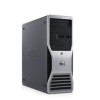Dell Precision 490 Desktop User's Guide - Page 56
Removing an Optional Third Hard Drive Tower Computer Only
 |
View all Dell Precision 490 Desktop manuals
Add to My Manuals
Save this manual to your list of manuals |
Page 56 highlights
1 power cable 4 optional SAS contoller card 2 SAS data cable 5 SAS cable 3 SAS hard drive NOTICE: If only one hard drive is to be installed, it should be connected to the SATA0 connector on the system board. 12. Ensure that all connectors are properly cabled and firmly seated. 13. Rotate the hard-drive carrier back into place (see Rotating the Hard-Drive Carrier Back into the Computer). 14. Replace the computer cover (see Replacing the Computer Cover). NOTICE: To connect a network cable, first plug the cable into the network port or device and then plug it into the computer. 15. Connect the computer and devices to electrical outlets, and turn them on. See the documentation that came with the drive for instructions on installing any software required for drive operation. NOTICE: In a mixed configuration of two SAS drives and one SATA drive, the SATA drive must be the boot (primary) drive and must go in the FlexBay. 16. If the drive you just installed is the primary drive, insert bootable media into drive A. 17. Enter the system setup program (see System Setup), and update the appropriate Drive option. 18. Exit the system setup program and reboot the computer. 19. Partition and logically format your drive before you proceed to the next step. See the documentation for your operating system for instructions. 20. Test the hard drive. See Dell Diagnostics for instructions. 21. If the drive you just installed is the primary drive, install your operating system on the hard drive. Removing an Optional Third Hard Drive (Tower Computer Only) CAUTION: Before you begin any of the procedures in this section, follow the safety instructions in the Product Information Guide. CAUTION: To guard against electrical shock, always unplug your computer from the electrical outlet before opening the cover. NOTICE: To prevent static damage to components inside your computer, discharge static electricity from your body before you touch any of your computer's electronic components. You can do so by touching an unpainted metal surface on the computer. NOTICE: To avoid damage to the hard drive, do not set it on a hard surface. Instead, set the drive on a surface, such as a foam pad, that will sufficiently cushion it. 1. If you are replacing a hard drive that contains data that you want to keep, back up your files before you begin this procedure. 2. Follow the procedures in Before You Begin. 3. Remove the computer cover (see Removing the Computer Cover). 4. Remove the drive panel (see Removing the Drive Panel). NOTICE: If metal shields are present in your computer configuration, they must be installed at all times while your computer is in use or your computer may not function properly. 5. If metal shields are present in your computer (see About the Metal Shields Present in Some Drive Configurations): slide the sliding-plate lever to the right and hold it in place as you pull to remove the vented metal insert from the FlexBay. 6. Disconnect the power cable from the back of the hard drive.















